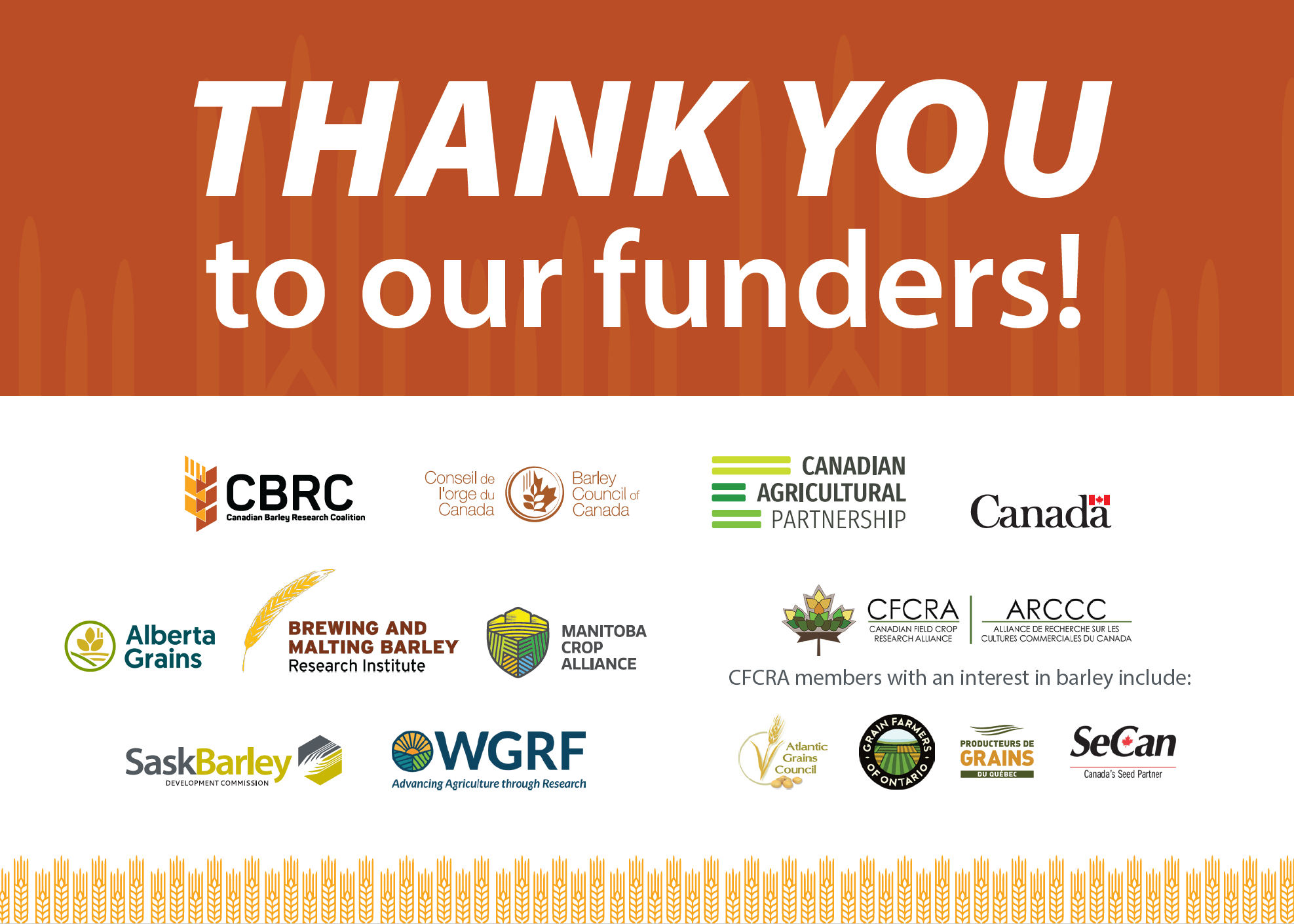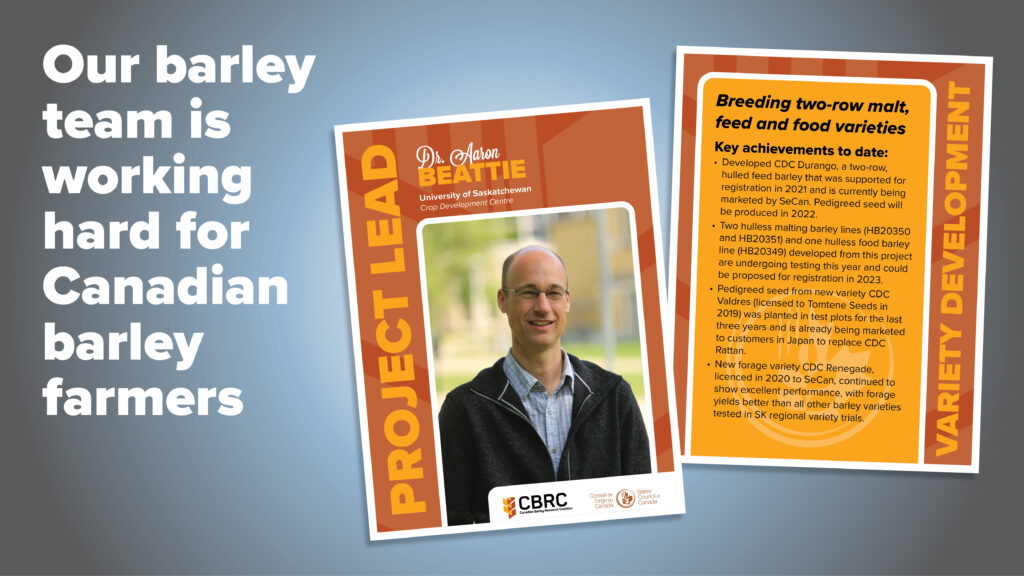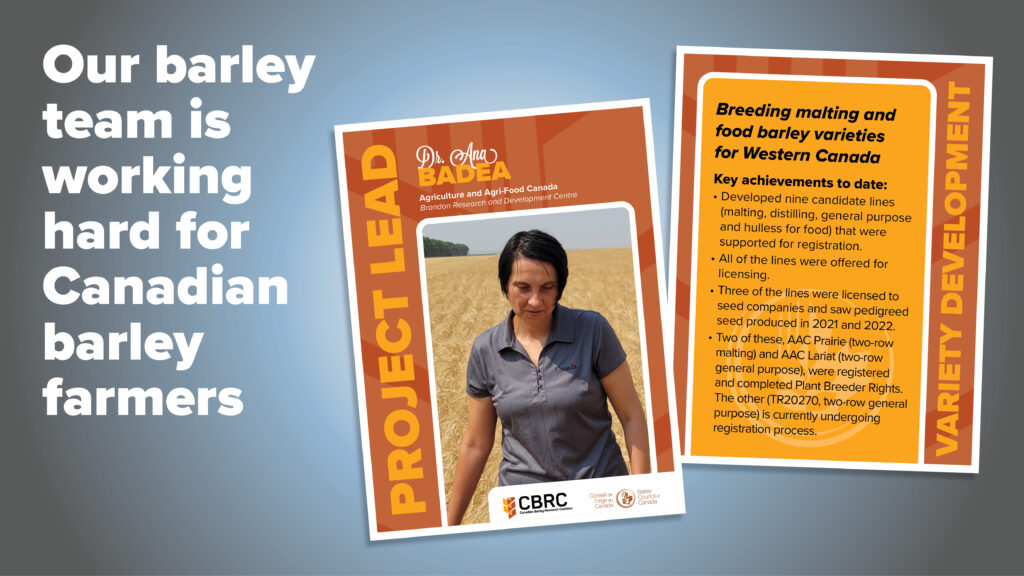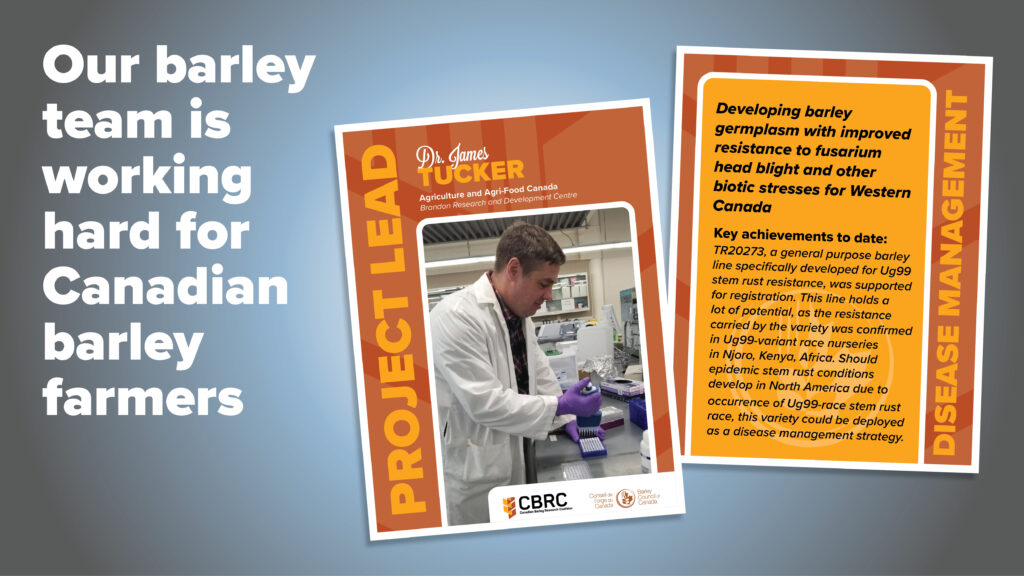Research
National Barley Cluster 2018-2023
The Barley Council of Canada is the recipient and administrator of the $10.2 million National Barley Cluster under the Federal Government’s CAP AgriScience Program on behalf of Canadian barley industry funders. The Canadian Agricultural Partnership (CAP) is a five-year (2018-2023), $3 billion investment by federal, provincial and territorial governments to strengthen the agriculture and agri-food sector. Barley Cluster industry funders supporting this Cluster include: Saskatchewan Barley Development Commission, Alberta Grains, Western Grains Research Foundation (WGRF), Brewing and Malting Barley Research Institute (BMBRI), Grain Farmers of Ontario, Producteurs de grains du Quebec, SeCan, Manitoba Wheat and Barley Growers Association, and Atlantic Grains Council.
Priority areas of CAP include enhancing the competitiveness of the sector by advancing its science and innovation capacity, and adoption of innovative products and practices with a focus on sustainable and clean production. The overall goals of the Barley Cluster research projects are to improve the quality traits of Canadian barley to satisfy the diverse and evolving needs of our customers and to ensure that barley production remains competitive with other major crops in Canada. Research areas within the Cluster include variety development, agronomic productivity, disease resistance, quality & performance, and sustainability.
Learn more about the Barley Council of Canada and the National Barley Cluster at: https://www.barleycanada.com/research/

Variety Development
-
Project lead:Dr. Aaron Beattie,University of Saskatchewan Crop Development Centre
Timeline: 2018-2023
Total Funding: $1,091,067Funders:
AAFC $545,532
Alberta Grains $188,937
WGRF $178,286
SaskBarley $113,312
BMBRI $65,000Both malt and feed barley are extremely important crops to Canada’s agriculture portfolio. Canadian malting barley generates billions in domestic government revenues annually in the form of product, income and corporate taxes on beer.Malt sold through export adds additional value to the Canadian economy.Canadian feed barley is also critical to the livestock and value-added industries. Demand from both these segments is expected to continue to grow in the future
To prepare for and nurture this growth, it is critical that we continue to develop barley varieties with improved traits.
The University of Saskatchewan’s Crop Development Centre has an established record of breeding and releasing two-row barley varieties within Canada that have a large impact on producers and end users. This project will focus on making improvements to current two-row barley varieties to support current markets, while expanding breeding efforts into new classes, such as malting types for the craft brewing and distilling industry and coloured types for the food industry, which may provide opportunities for new barley markets to develop.
The overall goal of this work is to maintain barley as a viable crop within producers’ rotations. It also aims to provide value to maltsters and brewers through higher selectability and greater extract, and to the feed industry through higher protein and lower acid detergent fibre.

Watch the video
-
Project lead: Dr. Ana Badea, Agriculture and Agri-Food Canada, Brandon Research and Development Centre
Timeline: 2018-2023
Total Funding: $1,685,804Funders:
AAFC $842,902
SaskBarley $300,000
WGRF $277,394
Alberta Grains $151,600
BMBRI $82,780
MWBGA $31,128Barley is a versatile crop grown for malting, feed and food across Canada.
In order to increase the growth of this crop in western Canada it is critical to continue to develop improved varieties adapted for the growing conditions and offering ideal end use qualities.
This project aims to develop improved two-row covered malting barley varieties and two-row hulless food barley varieties for western Canada.
The barley breeding program at the Brandon Research and Development Centre
is based on a consistent breeding pipeline with diversified populations and trait variation to produce elite germplasm and improved malting and food varieties. It has access to a variety of resources that will reduce the time required to breed new varieties, including greenhouses and growth chambers, a winter nursery, and disease nurseries to screen exotic material and elite breeding lines. It also employs some of the most advanced breeding technology available today, including double haploid production and molecular/genomic-assisted breeding, which allows for early generation screening, shortened breeding cycles and increased breeding efficiency.The overall aim of this project is to replace or improve on barley varieties that are currently grown in western Canada, through better protection from biotic and abiotic stresses, higher yields and greater marketability. Ultimately this will increase profitability for producers and end users.

Watch the video
-
Activity 4: Breeding barley for high yield and resistance to fusarium head blight for eastern Canada
Project lead: Dr. Raja Khanal, Agriculture and Agri-Food Canada, Ottawa Research and Development Centre
Timeline: 2018-2023
Total Funding: $1,041,101Funders:
AAFC $564,562
GFO $172,901
SeCan $139,580
PGQ $64,632
BMBRI $28,639
AGC $3,278There is a demand for barley in eastern Canada.However, barley can be a challenge to grow in the region for a number of reasons.A lack of locally adapted varieties pose agronomic challenges and lower yields in comparison to other crops. Plant diseases, including susceptibility to fusarium head blight (FHB)which leads toa high concentration of deoxynivalenol (DON) in the grain, reduce quality and challenge market acceptance.
Therefore, higher-yielding, FHB-resistant, and good quality barley cultivars are needed for the region.
This project aims to help make this happen by developing barley varieties in two- and six-row types with higher yield, improved resistance to FHB and good standability over current varieties. It will also evaluate lines from western Canada and other breeding programs for suitability and adaptation to eastern Canada with FHB resistance and low DON accumulation.
The outcome of the project will be new barley varieties with higher yields and better resistance to FHB as well as other emerging diseases, which will result in increased profitability for producers, increased competitiveness of barley among other cereal crops
and decreased input costs.
Watch the video
-
Project lead:Dr. Thomas Kelly Turkington, Lacombe Research and Development Center, Agriculture and Agri-Food Canada
Timeline: 2018-2023
Total Funding: $409,500Funders:
AAFC $286,650
Alberta Grains $78,317
SaskBarley $37,414
BMBRI $7,119Since 2000, seeded barley acres in Canada have decreased by nearly half, with producers increasingly turning to other, more competitive crops such as canola. One of the main reasons for this is the threat of diseases in barley.
In general, average yield losses due to leaf disease in susceptible varieties can be higher than 30% when conditions are favourable. And while control methods such as foliar fungicides are available, they are a costly added input and there is some evidence that there is a growing amount of resistance to them. The best protection appears to be choosing varieties with good levels of disease resistance.
Therefore, continued research is needed to improve varieties and production systems to maintain or lower production costs while improving net returns. This research aims to do this by developing disease-resistant barley varieties.
The results from previous projects demonstrated that field screening for scald, net blotch and stripe rust of barley has been effective at identifying and selecting resistance. This research will ensure we have the ability to accurately phenotype barley breeding material and germplasm for resistance to a range of barley diseases. It will also use disease nurseries to develop and assess disease and reactions to identify the most impactful and cost-effective sources of resistance.
The overall outcome of this research will be the development of varieties with increased disease resistance, which will decrease biotic production risks, improve crop yields and quality, lower production costs, reduce pesticide inputs, and ultimately lead to more marketable products domestically and internationally. In the long term, disease resistance also leads to reduced reliance on agrichemicals, which benefits the environment and helps to maintain a healthy and nutritious food supply, while decreasing production costs for producers.

Watch the video
-
Project lead:Dr. François Belzile, Université Laval
Timeline: 2018-2023
Total Funding: $500,827Funders:
AAFC $350,579
SaskBarley $45,000
PGQ $42,798
GFO $42,450
Alberta Grains $20,000One of the most cost-effective tools we have today to adapt to the anticipated impacts of climate change is plant breeding, which can incorporate resistance to existing and emerging diseases and pests. One of the more recent advances of the plant breeding process has been the adoption of genetic markers, which are tools that allow breeders to more rapidly develop new varieties with improved traits.
While genetic markers have afforded us great advances already, there is potential to increase their efficiency even more while also decreasing the costs associated with them.
This research aims to develop low-cost, medium-coverage genotyping tools for barley and soybeans, by exploring different approaches to achieving the low cost point necessary to make marker work more affordable to breeders.
The targeted outcome of this research will be a marked reduction in genotyping costs, which will speed up the usage of DNA markers by breeders and enhance their ability to select superior lines in response to a changing climate and emerging threats.

Watch the video
-
How does barley breeding impact farmers?
What is the importance of variety development research to farmers?
How do you ensure new varieties possess desirable traits?
In addition to yield and quality, what other traits are important when breeding a new variety?
What role do genetic markets play in variety development?
What advances do we expect to see in barley breeding in the near future?
Feed Barley
-
Project lead: Dr. Ruurd T. Zijlstra, University of Alberta
Timeline: 2019-2023
Total Funding: $431,941Funders:
AAFC $302,357
Alberta Grains $63,496
SaskBarley $63,496
MWBGA $2,592Feed grains remain the default market for crops after human consumptionand biofuels.Though we know that barley holds great value to the livestock feed industry, as it can provide feed energy and it has the potential to enhance gut health of animals, it is currently only evaluated for swine diets based on its energy value.
Increasing the use of barley as feed for energy and gut health would be good for both the feed industry and for the long-term sustainability of the barley industry.
This research aims to enhance the competitiveness of barley for swine diets by substantiating how and why barley provides value-added benefits to swine diets as more than just a source of energy. For example, barley could help eliminate the need for antibiotics as a growth promotant in livestock diets by serving as a prebiotic, thereby meeting the increasing market demand for meat produced without antibiotics. Using barley as feed could also allow for higher inclusion levels of co-products such as dried distiller’s grains and solubles.
The impact of this research will be an increase in demand for barley as feed. Promoting barley as a healthy ingredient for feed could potentially open up a market of 25 million piglets annually in Canada alone.

Watch the video
Disease Management
-
Project lead:Dr. Thomas Kelly Turkington, Lacombe Research and Development Center, Agriculture and Agri-Food Canada
Timelines: 2018-2023
Total Funding: $642,864Funders:
AAFC $450,004
Alberta Grains $98,543
SaskBarley $75,003
BMBRI $13,000
MWBGA $6,314Since 2000, seeded barley acres in Canada have decreased by nearly half, with producers increasingly turning to other, more competitive crops such as canola.
One reason for this is the threat of diseases in barley and the increasing resistance and adaption of these diseases to fungicides.
There are several things that must be done to help combat disease problems. First, we must encourage responsible stewardship of fungicides by producers as well as the agrichemical and farm supply industries and also develop and adopt more integrated disease management strategies.
Second, we must continually monitor barley leaf disease pathogens for shifts in host virulence and fungicide sensitivity in order to gain an adequate understanding of the prevalence, severityand variability of current plant pathogens as well as new emerging disease issues. This is what this research aims to do.
The outcome of this project will be a better understanding of pathogen variation, which will help us develop resources for developing resistant varieties and integrated strategies to prolong the effectiveness of host resistance and fungicides. This knowledge and understanding will help us increase the effectiveness and durability of strategies such as host resistance and fungicide application.

Watch the video
-
Lead researcher: Dr. James Tucker, Agriculture and Agri-Food Canada, Brandon Research and Development Centre
Timeline: 2018-2023
Total Funding: $2,020,798Funders:
AAFC $1,414,558
WGRF $230,740
SaskBarley $175,000
Alberta Grains $95,500
BMBRI $90,000
MWBGA $15,000Barley is a versatile crop grown across Canada for malting, feed, forage and food. However, barley acreage has been declining as it competes with other crops.
In order to stay competitive it is crucial to continually develop new barley varieties that will increase yields while also addressing disease threats and changing environmental, economic and market conditions.
This project aims to improve the competitiveness of malting and food barley varieties for western Canada. The main goals will be developing barley germplasm with improved resistance to fusarium head blight (FHB), stem rust, stripe rust and other biotic stresses and high priority diseases that currently affect barley production. The FHB nursery, which has been run by the Brandon Research and Development Centre for the past 16 years, is a key tool for developing this disease and stress resistant germplasm

Watch the video
Malting & Brewing
-
Project lead: Dr. Yueshu Li, Canadian Malting Barley Technical Centre (CMBTC)
Timeline: 2018-2022
Total Funding: $220,000Funders:
AAFC $110,000
SaskBarley $91,000
BMBRI $19,000Brewers around the world face a similar problem when it comes to brewing: premature yeast flocculation (PYF). This refers to what happens when yeast combines into clumps prematurely during fermentation, leading to undesirable beer quality and potentially substantial economic losses.
Previous studies have indicated that several factors involving malt and brewing can contribute to or cause PYF, but there are still outstanding questions about how it works.
This project aims to address that by studying PYF in the brewing process and identifying the factors that can trigger it. In particular, it will aim to identify the processing factors in malting that have the greatest impacts on the production of PYF positive malt and develop procedures to control these factors. It will also study the responses and interactions of different strains of yeast to PYF positive malt, and aim to improve test methods for quick assessment of malts with PYF potential.
The results generated from this project will benefit Canadian malting and brewing companies by helping to avoid production loss.
These benefits will extend to the entire malting barley value chain as better testing methods and reduced losses create value. The results may also encourage more barley to be selected for malting use, particularly in years with lessfavorable growing conditions which lead to a higher load of microorganisms on barley kernels that in turn can trigger PYF.

Watch the video
-
Project lead: Dr. Yueshu Li, Canadian Malting Barley Technical Centre
Timeline:2018-2022
Total Funding $300,000Funders:
AAFC $150,000
SaskBarley $131,000
BMBRI $19,000Canadian malting barley is in demand worldwide. One of the reasons for that is its contribution to beer flavour.
There is a growing demand from consumers for diverse and consistent flavours in their beer, so mainstream and all malt brewers are becoming more and more interested in understanding how their choice of barley malt affects the flavour of the final brewed product.
This is why it’s important to fully understand what qualities of malting barley affect beer’s flavour.
This project aims to do so by: characterizing the sensory attributes of specific malting barley varieties; understanding their origins; and testing if they can carry through the malting and brewing process into the final product.
The results of this research will allow us to gain an understanding of the sensory profile of different malting barley varieties and identify which sensory attributes (flavours and aromas) in beer are beneficial to the end product. It will also help us understand the impact of processing on sensory and flavour attributes.
Overall these results will help us expand current markets for Canadian malting barley and tap into new markets.

Watch the video
Crop Management
-
Lead researcher:Dr. Thomas Kelly Turkington, Lacombe Research and Development Center, Agriculture and Agri-Food Canada
Timeline: 2018-2023
Total Funding: $508,200Funders:
AAFC $355,740
Alberta Grains $71,930
SaskBarley $71,930
BMBRI $8,600Fusarium head blight (FHB) now affects most of Canada and can be a devastating disease. When conditions are favourable for its development, FHB can cause significant yield and grade losses and mycotoxin contamination. For barley producers, this usually results in a rejection for malt status.As the disease continues to spread, the potential production area for the selection of malting barley without detectable levels of deoxynivalenol (DON) becomes smaller and smaller.
Further complicating the matter, there is currently a lack of effective management or prevention options for the disease.
However, we do know that using an integrated crop management approach can lessen the impact. This research project aims to help us learn more about this by investigating potential cropping strategies that may help to reduce variability in crop development, and by increasing the extent of host tissue coverage with fungicides by focusing on seeding rates, fungicide timings and water volumes. Overall the research aims to determine how we can improve our ability to reduce FHB and potential mycotoxin contamination in barley and ultimately improve the quality of the resulting malt.
Improving our ability to manage FHB will make barley a more attractive cropping option for producers and a better product for maltsters.

Watch the video
-
Lead researcher:Dr. Aaron Mills & Dr. Breanne Tidemann, Agriculture and Agri-Food Canada
Timelines: 2018-2023
Total Funding: $450,000Funders:
AAFC $315,000
Alberta Grains $68,000
SaskBarley $47,000
BMBRI $20,000Part of the challenge of growing malting barley is managing protein levels in the crop. Malt standards require a specific level of protein in the crop and protein levels can be affected by a number of factors including the use of nitrogen fertilizer and the soil.
To try to manage protein levels, producers will plant barley following canola rather than legume crops, such as field peas, which fix nitrogen and leave residual nitrogen in the soil. However, emerging research has shown that residual nitrogen from legumes does not increase protein levels as much as inorganic nitrogen applied at seeding.
This study aims to help give producers better guidelines for managing protein levels, by determining how to successfully grow malt barley after legume crops across Canada. The study, which will take place in 13 diverse locations across Canada, will span a diversity of agronomic practices as well as soil and environmental conditions to determine which legume crops in each region are more suitable as preceding crops to malt barley than others. It will also investigate whether split applications of nitrogen can increase malt barley yield while maintaining lower protein levels.
The resulting data will help Canadian barley producers make more informed choices regarding their cropping systems. It will also give them the ability to increase yield while maintaining malt quality, thereby increasing profits. It will also help develop practices to minimize nitrogen inputs, reducing the environmental impacts of growing malting barley.

Watch the video with Dr. Breanne Tidemann
Watch the video with Dr. Aaron Mills
Building Barley Better
The Building Better Barley Podcast
View the Building Better Barley 2019 brochure and 2019 magazine.



